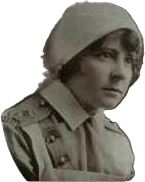While walking with my wife past one of the town's many graveyards, we went in to examine the eagle's nest that we could see from the road.
Once I got close to the tree, as a retired Canadian Forces Nursing Officer, this headstone stood out for me. She was a WWI nurse so I showed the picture of her marker to a colleague in Halifax who was able to find some background on her from our nursing archives.

https://www.halifaxvghnursesalumni.ca/

Nursing Sister Jessie MacDonald (Victoria General (VG) graduate, class of 1915) was the Head Nurse in the VG Hospital's Operating Room following the Halifax explosion, on 6 December 1917. The nurses, doctors, and auxiliary staff worked continuously for the first 2-3 days following the explosion. Five hundred windows were blown out from the explosion, with glass everywhere. A snowstorm started that evening, and the arrival of family and friends seeking relatives added to the chaos. Following this experience, Jessie resigned and joined the #7 Dalhousie Medical Unit as a Nursing Sister in WWI and served overseas.
https://www.halifaxvghnursesalumni.ca/filemanager/files/1917%20Hfx%20Exp.pdf
I returned on 11 November, 2024 to place a wreath and a small plaque commemorating her accomplishments.

Canadian Army Medical Corps Nursing Sisters
More than 2,800 trained civilian nurses enlisted with the Canadian army during the First World War, becoming the first women in the modern world to hold military commissions as officers. As members of the Canadian Army Medical Corps (CAMC), the nursing sisters treated and cared for wounded soldiers overseas and at home. At least 58 died from disease or enemy action during the war.
Key Facts: Canadian Military Nurses in the First World War***
The Canadian Army Medical Corps (CAMC) was established in 1904 and included a permanent nursing service.
Military nurses were known as “nursing sisters.” They were nicknamed "bluebirds" because of their blue dresses and white veils.
2,845 nursing sisters served in the CAMC during the First World War.
At least 58 nursing sisters died (21 from direct enemy action).
CAMC nursing sisters served in Canada, England, France, Belgium, Russia, and in the Mediterranean at Gallipoli and Salonika.
Lest We Forget